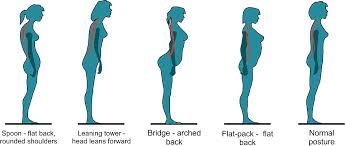Women whose heads lean forward are most likely to be currently suffering from back or neck pain (58%), followed by those with an arched back (56%).
Women whose heads lean forward are also the most likely to suffer from back or neck pain ‘every day’ (29%). Those with a flat back were the least likely to have experienced pain, with 21 per cent having remained pain-free.*
Although many women would recognise what category they fall into when it comes to the more traditional body shapes, knowing about their side-shapes is important too.
BCA Chiropractor, Tim Hutchful, comments: “Rather than worrying about being an apple or an hourglass, we want people to think about what they look like from the side. Paying closer attention to your body’s side profile can really help to identify back or neck pain triggers.”
What side-shape are you?
• Spoon – flat back, rounded shoulders
• Leaning tower – head leans forward
• Bridge – arched back
• Flat-pack – flat back
With just over 25 per cent of women saying that a bout of back or neck pain can last for one to three days at a time, it is important to pinpoint what can be done to prevent it. Fortunately, making changes to your posture doesn’t call for extreme dieting or exercise programmes.
Tim Hutchful explains: “The perfect posture should give you a neutral side-on appearance, with your ears, shoulders, hips, knees and ankles in line.
“People who want to improve their back and neck pain symptoms through a better posture should try imagining they have a plumb line hanging straight from their ears to ankles – with everything in the middle sitting on the same line.
“One way to do this is to try standing in a relaxed way and then gently contracting the abdominal muscles. When sitting, the gravity line should pass thorough ear, shoulder and hip.”
The BCA has also developed a programme of simple stretches and exercises, designed to improve posture and help prevent back pain by promoting balance, strength and flexibility in the spine. Click here to view.
Research carried out on behalf of the BCA in January 2015.

